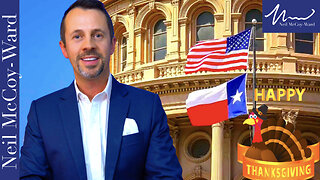Premium Only Content

Revelation of the Method: How Media Prepares Us for Hidden Agendas and Realities
The concept of hidden truth runs deep in the modern world, where information is layered, disguised, or presented as entertainment. From the notion of revelation of the method to the tactic of predictive programming and the phenomenon of truth in plain sight, these mechanisms shape public consciousness in ways both subtle and overt. We see these methods applied across media, embedding ideas of surveillance, control, and even extraterrestrial presence in humorous or exaggerated formats that make them easy to dismiss. Here’s a deep dive into these concepts and how satire—like that in Weird Al’s music video parodying conspiracies—manages to both mock and, perhaps, expose elements of hidden control in our society.
Revelation of the Method: Controlled Exposure of Hidden Truths
Revelation of the method refers to a strategic unveiling of hidden agendas or secrets in ways that are unlikely to be taken seriously by the general public. By revealing an agenda or truth within an absurd or satirical context, the information is effectively dismissed by viewers as entertainment rather than reality. Those in control can feel secure in their disclosure, believing that people have been informed—even if they choose not to believe it. This approach can deflect scrutiny while embedding deeper messages in the public consciousness.
In Weird Al’s parody, he humorously describes classic conspiracy motifs: shadow organizations, hidden world domination plots, and even the infamous aluminum foil hat—a satirical nod to those who believe the government or aliens may read minds. The humor here serves as both a critique and a subtle form of disclosure; while it may exaggerate, it mirrors genuine concerns about surveillance, media manipulation, and technological intrusion. The parody becomes both a release valve for public anxiety and a possible vehicle for hidden truths. What if there are kernels of reality within these exaggerated conspiracy themes?
Predictive Programming: Preparing the Public Mind
Predictive programming suggests that, by presenting future scenarios repeatedly in media, those scenarios become familiar and more acceptable if they later unfold in reality. This technique is often used to desensitize audiences to drastic societal changes, whether it’s normalized surveillance, biotechnological advancements, or even authoritarian control. From dystopian films that mirror our current state of surveillance to animated shows like The Simpsons that eerily predict political events, this subtle conditioning could be preparing us to accept the seemingly inevitable.
In his music video, Weird Al playfully addresses themes like thought control, shadow elites, and secret government activities. By weaving these ideas into a satirical narrative, he brings them into cultural awareness in a way that could lessen our shock if we eventually face similar realities. When ideas like surveillance or mind control are portrayed as ridiculous or comedic, they subtly train the public to view these subjects as either implausible or somehow distant. Yet, as these notions gain traction in entertainment, we may be less likely to resist or even question their real-world applications. Predictive programming, therefore, functions as a primer, acclimating society to future possibilities.
Truth in Plain Sight: Hiding Reality Within Fiction
Truth in plain sight is the idea that certain truths are openly displayed but framed in such a way that the general public dismisses them as mere entertainment or fantasy. By revealing information in an exaggerated, fictionalized format, those in power can disclose truths without fear of real accountability. This approach relies on cognitive dissonance: the tension between seeing something as fiction and accepting it as fact.
Consider how “foil hats” in Weird Al’s video are both a comedic device and a reference to real concerns about mind control and surveillance. The absurdity of the foil hat, a symbol of over-the-top paranoia, distracts from the deeper issues of privacy invasion and cognitive freedom. This layering of humor over potential truth allows viewers to laugh, but in laughing, they’re also engaging with the very ideas they might otherwise find uncomfortable or conspiratorial. Humor here is not only entertainment but a shield, protecting viewers from grappling too closely with unsettling possibilities.
The Role of Satire: Humor as Both Mask and Mirror
Satire is one of the most effective methods for critiquing and revealing the absurdities of control systems, and it often speaks to truths that would otherwise provoke resistance. Through humor, satire allows us to confront issues indirectly, lowering our defenses and allowing us to consider perspectives we might otherwise reject. This is why conspiracy theories are so often portrayed in media through humor or exaggeration—this approach keeps them safely distanced from serious consideration while subtly engaging the audience in a complex dialogue.
Weird Al’s parody, for example, pokes fun at conspiracies, but it also validates people’s instinctive doubts about government transparency, surveillance, and hidden agendas. By addressing conspiracies with humor, the video underscores society’s fascination with unseen power structures while questioning how deeply these suspicions resonate in our cultural psyche. This blend of satire and subtle critique encourages viewers to maintain both a sense of humor and a critical lens—a balance that allows for questioning without fear or cynicism.
Conclusion: The Interplay of Comedy and Consciousness
When it comes to hidden agendas, predictive programming, and truth in plain sight, entertainment becomes a powerful tool in shaping public perception. Through humor, exaggeration, and satire, ideas that would typically provoke resistance are softened and absorbed into the cultural landscape. We laugh at the absurdity of foil hats while consuming subtle commentaries on privacy invasion and manipulation. These media portrayals walk a fine line between fiction and fact, easing us into realities we might otherwise resist.
In the end, the questions raised by satirical portrayals like Weird Al’s may linger: Are we watching pure comedy, or are we being told something within the humor? By presenting conspiracy theories in such a lighthearted manner, media may provide an invitation to think critically, to question narratives, and to discern what, if anything, might be true behind the laughs. Perhaps there’s more to humor than meets the eye—a tool to reveal, to distract, or even to prepare us for a reality hiding in plain sight.
-
 0:40
0:40
FragmentsOfTruth
13 hours agoThe True Cost of Manufacturing: How the iPhone 14 Highlights Global Production Dynamics
681 -
 20:10
20:10
DeVory Darkins
7 hours ago $0.97 earnedThe View ERUPTS Over Call for Biden to Pardon His Son
1.83K24 -
 LIVE
LIVE
GamingChad
3 hours agoMS Flight Simulator 2024 - Lets Make this Turkey Fly -Career mode Pt.2
964 watching -
 LIVE
LIVE
Pepkilla
4 hours agoHappy Thanksgiving ~ Wumble StwEeeem
295 watching -
 7:24:25
7:24:25
Rotella Games
1 day agoThanksgiving Side Missions & Hangout | GTA San Andreas
17.5K2 -
 LIVE
LIVE
MafiaTwin
3 hours agoFrist Stream On Rumble
228 watching -
 19:41
19:41
Neil McCoy-Ward
7 hours agoFinally! Some Good News Today... (& Happy Thanksgiving!)
6.17K -
 LIVE
LIVE
tacetmort3m
8 hours ago🔴 LIVE - (HAPPY THANKSGIVING!) BACK WITH MORE STALKER ACTION - STALKER 2 - PART 7
106 watching -
 58:05
58:05
The Tom Renz Show
3 hours agoThanksgiving In America 2024 - With Mark Sherwood
3.84K1 -
 1:13:41
1:13:41
DDayCobra
5 hours ago $7.38 earnedHappy Thanksgiving!
34.4K2